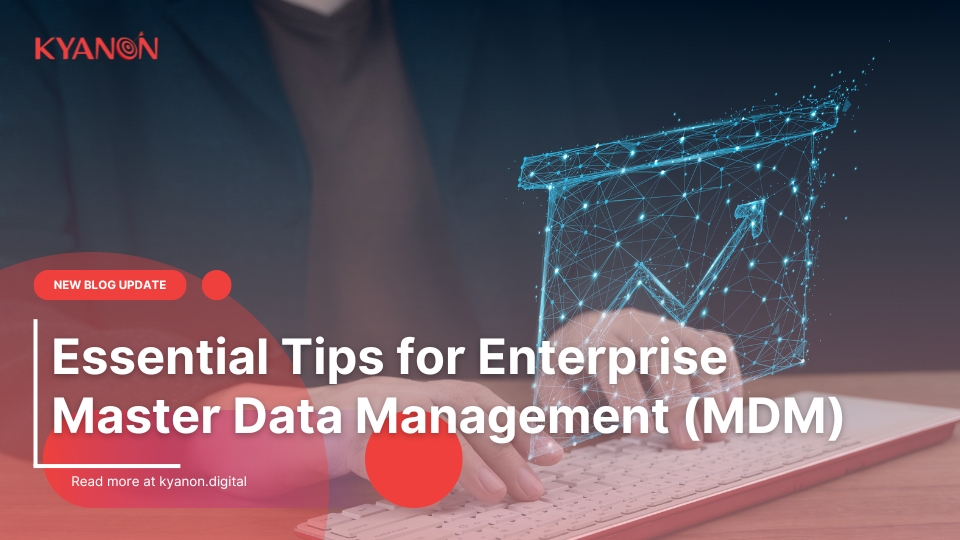In today’s data-driven world, organizations face the challenge of managing an overwhelming amount of information to remain competitive. Enterprise Master Data Management (MDM) is the solution. By implementing an MDM strategy, companies can effectively manage their data and unlock its full potential.
Let’s Kyanon Digital walk you through the essential tips for enterprise master data management in this blog.

1. A Guide to Enterprise Master Data Management
Enterprise Master Data Management is a strategy that helps organizations achieve a clear, reliable, and consistent view of their data across various systems, departments, and locations. This approach enhances process efficiency, improves decision-making, and boosts overall operational effectiveness.
MDM is essential for maintaining data consistency and integrity across an organization. It ensures that data is standardized, verified, and easily accessible to relevant stakeholders. By removing data silos and inconsistencies, MDM enables organizations to make well-informed decisions based on accurate and up-to-date information.
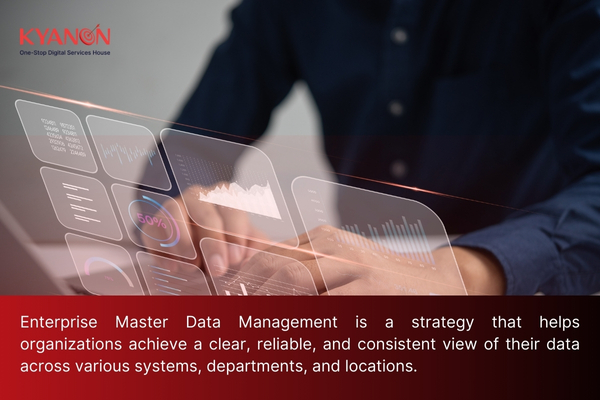
2. The Challenges of Managing Data in a Big Business
Large organizations frequently encounter major challenges in data management. With data generated from numerous sources and stored across various systems, the result is often fragmented and inconsistent information. This fragmentation can cause errors, duplication, and inefficiencies across different departments.
In the absence of a centralized data management approach, organizations find it challenging to uphold data quality and integrity. This lack of centralization makes it hard to rely on available information, resulting in subpar decision-making and missed prospects. Moreover, concerns regarding data security and compliance loom large, particularly given the rising risk of cyberattacks and data breaches.
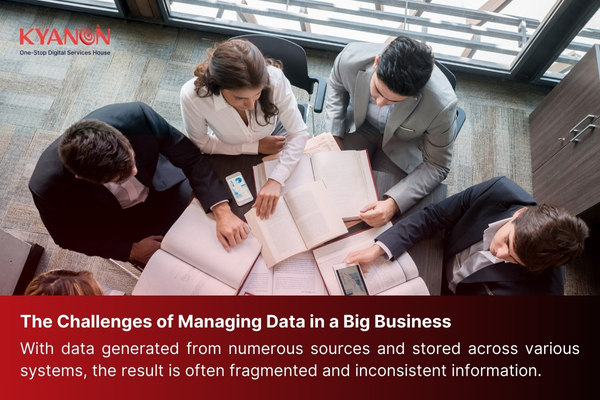
3. Benefits of Enterprise Master Data Management
Implementing enterprise MDM offers several advantages for organizations.
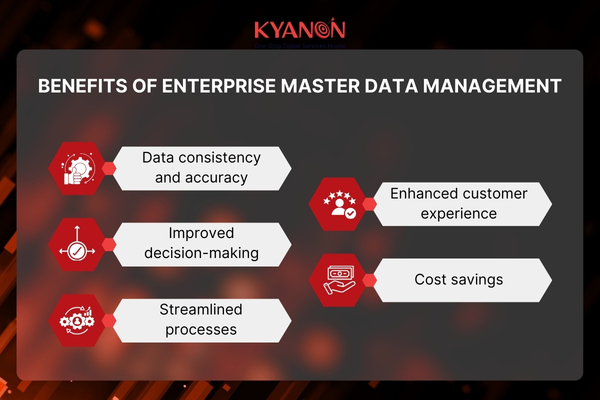
3.1. Data consistency and accuracy
MDM ensures that all data remains consistent, standardized, and accurate, irrespective of its origin or the system it resides in. This eradicates data discrepancies and fosters trust in data for decision-making purposes.
3.2. Improved decision-making
Armed with reliable and current data, organizations can swiftly and confidently make informed decisions. MDM provides a singular source of truth that enables stakeholders to access pertinent information when needed.
3.3. Streamlined processes
MDM enables organizations to enhance their processes by eliminating redundant data entry, minimizing manual errors, and automating data integration. This results in heightened operational efficiency and productivity.
3.4. Enhanced customer experience
By possessing a comprehensive and precise understanding of customer data, organizations can deliver personalized and targeted experiences. MDM equips organizations to comprehend their customers better, predict their requirements, and offer exceptional service.
3.5. Cost savings
MDM aids organizations in cutting costs by curbing data duplication, eradicating manual data reconciliation efforts, and enhancing data quality. Additionally, it mitigates the risk of non-compliance penalties and data breaches, both of which can incur substantial expenses for organizations.
4. Creating a Strategy for Enterprise Master Data Management
Crafting an enterprise MDM strategy necessitates meticulous planning and alignment with organizational objectives. Here are essential steps to guide you.

4.1. Assess the current data landscape
Gain insight into your organization’s existing data landscape, encompassing systems, processes, and data sources. Identify data quality issues, duplication, and areas for enhancement.
4.2. Define business objectives
Clearly articulate the business goals that MDM seeks to accomplish. Identify key performance indicators (KPIs) to gauge the effectiveness of your MDM strategy.
4.3. Establish data governance
Develop policies, processes, and roles for data governance within your organization. Consider employing a dedicated data governance solution and ensure clear accountability for managing data quality, security, and compliance.
4.4. Select appropriate technology
Choose an MDM solution that aligns with your organization’s needs, considering factors like scalability, flexibility, and integration capabilities with existing systems.
4.5. Data migration and integration
Devise a comprehensive plan for migrating and integrating data into the MDM system. Ensure thorough cleansing, validation, and mapping of data to the relevant fields.
4.6. Implement change management and training
Deploy a change management strategy to facilitate seamless adoption of the MDM system. Provide comprehensive training and support to stakeholders to foster understanding of the benefits and proficient usage of the system.
5. Best Practices for a Successful MDM Implementation
For a successful enterprise MDM implementation, adhere to these best practices.
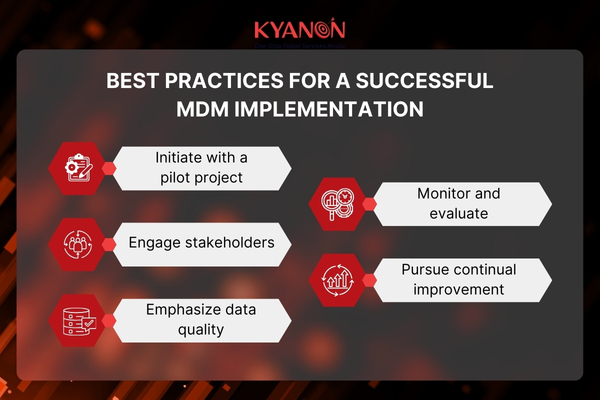
5.1. Initiate with a pilot project
Commence with a pilot project to validate the efficacy of your MDM strategy. This enables the identification of potential issues and allows for adjustments before expansion.
5.2. Engage stakeholders
Involve key stakeholders from various departments in the MDM implementation process. This ensures consideration of their needs, fostering ownership and support for the project.
5.3. Emphasize data quality
Maintain a focus on data quality throughout the implementation phase. Invest in activities like data cleansing, validation, and enrichment to ensure the accuracy and reliability of data in the MDM system.
5.4. Monitor and evaluate
Continuously monitor and assess the performance of your MDM system. Regularly review data quality metrics, KPIs, and user feedback to pinpoint areas for enhancement and make necessary adjustments.
5.5. Pursue continual improvement
Enterprise MDM is an evolving endeavor. Regularly evaluate and refine your MDM strategy to accommodate evolving business requirements, technological advancements, and data governance standards.
6. Selecting the Appropriate Enterprise Master Data Management Solution
The selection of an enterprise MDM solution is pivotal for the success of your implementation. Consider the following factors when assessing MDM vendors.
- Scalability: Ensure that the chosen MDM solution can accommodate your organization’s expanding data requirements and future growth plans effectively.
- Integration capabilities: Evaluate the MDM solution’s capacity to seamlessly integrate with your existing systems, databases, and applications. Smooth integration is essential for maintaining data consistency and accessibility.
- Data quality features: Seek MDM solutions that provide robust features for data cleansing, validation, and enrichment. These functionalities are imperative for upholding data accuracy and integrity.
- User-friendly interface: An intuitive interface plays a significant role in user adoption and usability. Look for an MDM solution with user-friendly navigation, customizable dashboards, and comprehensive search functionalities.
- Vendor support and reputation: Opt for a vendor with a proven track record in enterprise MDM and commendable customer support. Review customer testimonials, case studies, and references to gauge the vendor’s reputation.
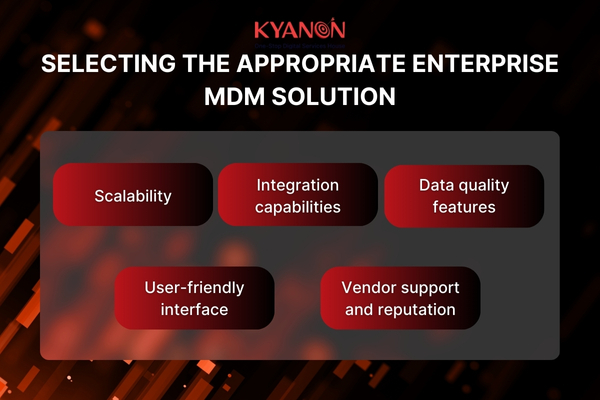
7. Kyanon Digital and Semarchy: Your Data partner for success
As organizations increasingly adopt digital transformation and prioritize data-driven decision-making, the significance of MDM will grow even further. MDM is poised to play a pivotal role in empowering organizations to leverage the potential of their data, providing them with a competitive advantage in today’s dynamic business environment.
Kyanon Digital has officially partnered with Semarchy, a globally recognized leader in unified data management platforms. This partnership brings together the innovative expertise of Kyanon Digital with Semarchy’s renowned solution, Semarchy xDM for enterprise.
Contact us for data management consulting services for your business today.
